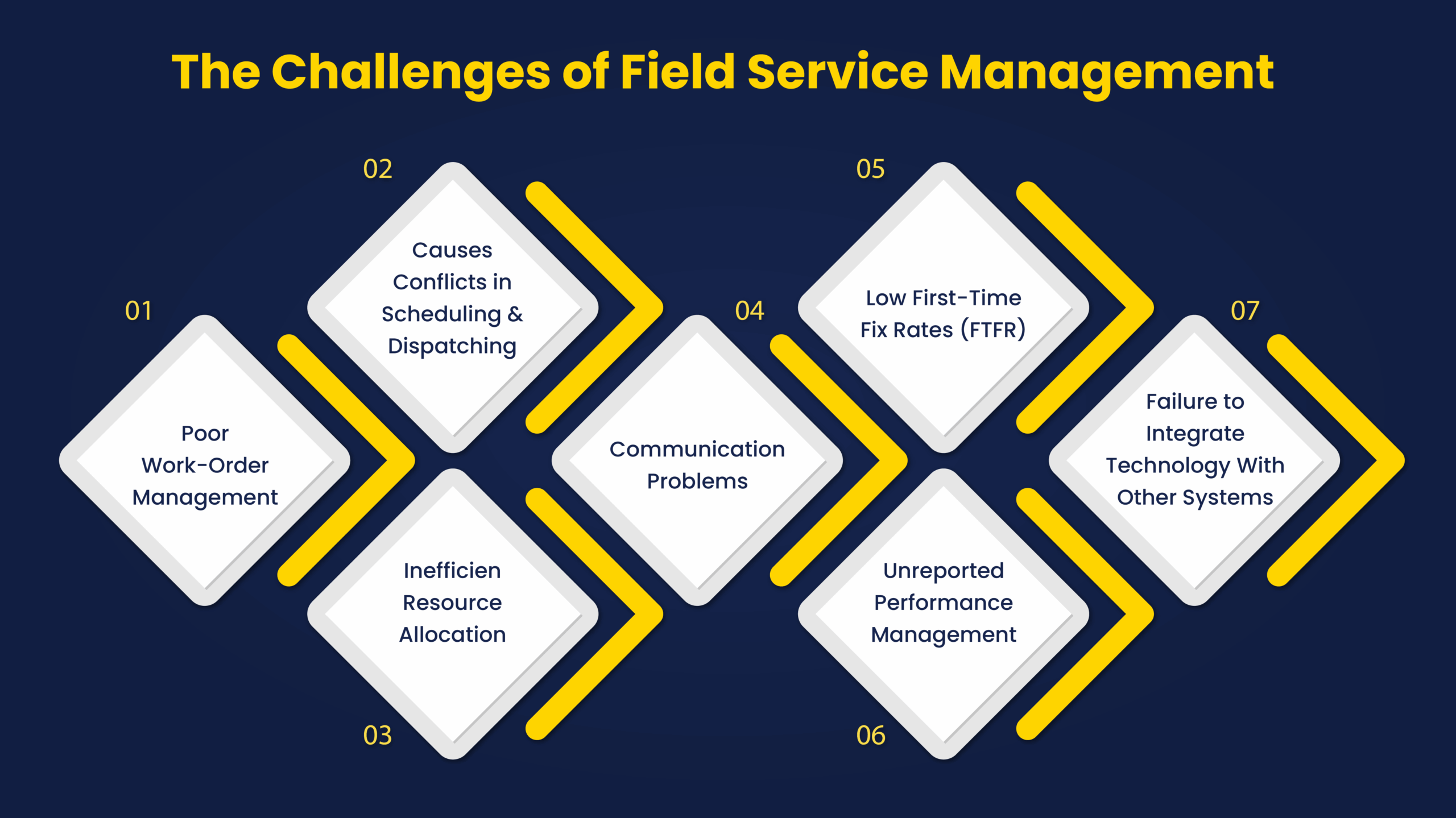When people hear “field technician,” they usually think of someone installing cable TV or a utility worker fixing a faulty HVAC system. But they do so much more.
Field technicians repair, maintain, and install technical equipment at customer sites or remote locations. They are also the face of your brand because their performance directly impacts how customers perceive your business.
For any business providing maintenance services, consistent service quality is the best way to happier customers.
But, if your technicians aren’t efficient or productive enough, your business takes a hit. It’s apparent that TEAM TECH determines whether your business grows or sinks, so it makes sense to increase their capacity for delivery.
In this blog, we’ll discuss the impact of field technicians, what happens when technicians are underproductive, and how the right field technician software helps them (and your business) perform at their best.
Managing Field Technicians for Efficiency and Productivity
Before we discuss how to increase the efficiency and productivity of field technicians, we must first identify several inefficiencies in field service operations. Only when you know and see how they silently eat away profit margins can you start to boost efficiency and increase productivity.
The Challenges of Field Service Management
This section explains the most common challenges field technicians face in service operations and the problems they cause. While Overhead Cost is a major FSM challenge, it’s not directly tied to technician efficiency or field technician software, unlike scheduling and communication
These are the challenges field technicians face in FSM:
1. Poor Work-Order Management
The ideal field service work order lifecycle has five primary stages for handling tasks: identify, assign, complete, record, and get feedback. If you miss or mess up the processes, your whole system wobbles. Any issue, small or big, will have a ripple effect on the entire organization. Imagine technicians showing up with the wrong tools or at the wrong service site.
2. Causes Conflicts in Scheduling and Dispatching
If accurate scheduling keeps the business going and satisfies customers, bad scheduling is a one-way ticket to chaos. Imagine double-booking, and two techs show up for the same job—or worse, none. Maybe a dispatcher assigns a customer request to someone on their day off. These common mistakes, made using spreadsheets, whiteboards, or other manual methods, lead to delays, rescheduling, low technician productivity, and upset customers.
3. Inefficient Resource Allocation
It’s easy to overwork some technicians and leave others twiddling their thumbs when you don’t know who’s doing what and where. This unused capacity is unfair (overworked staff) and expensive (wasted payroll). It also affects route planning. One missed turn, one unnecessary detour, and suddenly, you have failed appointments, customer complaints, and extra costs.
4. Communication Problems
Field service managers need to know the current status and location of their agents and technicians in the field and vice versa. Limited communication or miscommunication between field teams causes confusion, slower task reassignment, and missed deadlines, which hurt your reputation. You need a consistent and easy-to-use system designed for the job.
5. Low First-Time Fix Rates (FTFR)
“Field service efficiency” for technicians means handling customer service requests at the first trial.
If your team’s rates are slipping, it’s usually a sign of deeper issues: weak prep, lousy scheduling, or gaps in communication and inventory. Issues that field technician software can solve. Whatever the reason, repeat visits slow your team, eat into profit, and frustrate customers. Low FTFR may also cause technician productivity and morale.
6. Unreported Performance Management
Performance management in field service isn’t easy. If you rely on outdated systems or no system, you’ll never be able to track metrics such as response times or job completion rates.
You can’t keep shuttling between service sites to see who’s doing what. Without accurate, centralized performance data, you can’t see who (technician) needs help, who’s thriving, or where things are falling apart.
7. Failure to Integrate Technology With Other Systems
Field teams often get stuck juggling half-baked tools that don’t “talk” to each other. A technician might have a great app for scheduling, but if it doesn’t sync with inventory or reporting tools, it just adds more work. Why else would 62% of IT leaders say integration is one of their biggest headaches? You’re better off using technician software like Swivl, which packs all the good stuff in one place while being easy to use.
“The year is 2025, and we’re neck-deep in the digital age. But, it’s hard to believe that about 25% of FSM companies still use manual methods.”
The True Cost of Inefficiency in Field Service
In the previous section, we highlighted the sources of inefficiencies in field service operations, such as poor scheduling and communication breakdowns. Now, we’ll discuss their adverse effects. Poor scheduling can lead to assigning the wrong technician and poor customer service.
Knowing the cost of inefficiencies will push you to want to change things. Here’s a breakdown of how these inefficiencies affect you and your business in three major areas:
Increased Operational Cost
-
- Poor route planning affects your finances, especially for businesses with large fleets.
-
- How? Return trips burn more fuel; you pay for overtime, take fewer jobs, or lose customers.
-
- You could lose opportunities to increase revenue (primarily through upsells) because unhappy customers won’t purchase upgrades, accessories, or extra services.
Decline in Technician Productivity
-
- Your technicians will struggle with lower FTFR if scheduling is poor because you lack tools for skill-based matching
-
- More return visits = fewer new jobs, limiting how much work they do (which directly affects their skill set)
-
- Handling paperwork and scattered communication reduces the time for actual service delivery
Decreased Customer Satisfaction
-
- Poor service quality frustrates and discourages customers
-
- Customers stop patronizing you, and it doesn’t stop there. The negative reviews and word-of-mouth complaints can tarnish your brand
When technicians are inefficient, businesses struggle with operational challenges, dissatisfied customers, and revenue losses. Now, let’s see how we can leverage field technician software to ensure they perform at their best capacity.
“Field service management software is no longer optional!”
What Is Field Technician Software?
Field technician software is not another part of Field Service Management (FSM). Instead, it’s a solution (in digital form) that makes field operations easier. It removes the challenges we discussed earlier by automating key processes such as scheduling, dispatching, inventory management, and real-time tracking. This way, technician productivity and field service efficiency increases thanks to the right tools and information.
Key Features and Functionality
The global field service management market has a projected compound annual growth rate of 13.3% from 2023 to 2030.” (Grand View Research). These numbers mean there’s room for growth. However, the future is for those who can manage, scale, and optimize using field service software.
Field technician software plays a crucial role in this shift toward more efficient operations, and we’ll list and explain it to you in four main categories:
-
- Improving Work Order Management
-
- Optimizing Scheduling and Dispatch
-
- Enhancing Communication and Collaboration
-
- Streamlining Data Collection and Reporting
Improving Work Order Management
Work orders are the backbone of an efficient field service operation that ensures technicians do the job well. Technicians who get clear and detailed instructions, especially through mobile field service apps, work better.
A good work order doesn’t just say, “Fix the machine.” It says, “Replace the faulty motor in Unit 5 using a 10mm wrench.” See the difference?
Without this level of documentation and attention to detail via work order software, tasks slip through the cracks, deadlines get missed, and communication falls apart.
Optimizing Scheduling and Dispatch
Instead of assigning jobs by hand, automated scheduling and dispatch use key metrics—technician skills, certifications, qualifications, experience, location, availability, job urgency, even live traffic and weather conditions—to assign the best hands to customer requests.
Likewise, skill-based technician management reduces mistakes, boosts first-time fix rates, and helps your team handle more jobs with fewer delays. There is no guesswork, no back-and-forth, no chaos. Finally, the numbers back it up because McKinsey reports how automation improves technician availability by up to 30%.
Enhancing Real-Time Communication and Collaboration
Real-time communication isn’t a nice-to-have feature. It’s the secret sauce to faster service, better coordination, and happier customers while boosting your team’s productivity. For instance, mobile field service app software improves technician communication with other technicians, field service teams (especially dispatchers), and customers by using instant messaging, live updates, video calls, and push notifications accessible on one centralized platform.
A tool like Swivl helps businesses to maintain real-time communication for remote workforce management and allows technicians to:
-
- Get help the moment they need
-
- View LIVE updates to their job assignments
-
- See customer info, service history, or job notes right on their device
Likewise, dispatchers can:
-
- Properly assign and reassign work orders
-
- Reroute technicians in real-time
-
- Send schedule changes or job updates instantly
Also, the customers are never left in the dark since real-time communication gives them accurate ETAs, appointment reminders, and live updates on job progress. That transparency increases trust and satisfaction. Businesses that prioritize real-time customer experience retain 55% more customers than others who aren’t. (Aberdeen Group Research)
Streamlining Data Collection and Reporting
In field service, completing a job isn’t enough; you must be able REPEATEDLY to do it better, faster, and smarter. That’s where data collection and reporting come in, as it gives you the insights you need to IMPROVE.
When reports show key metrics like response times and job completion rates, technicians can identify and fix the root cause: a skills gap, a scheduling conflict, or an inefficient workflow. Also, technicians with accurate, real-time data will know each customer’s history, service requests, and personal preferences.
“No wonder 45% of 1,200 fleet managers and mobile-business professionals said fleet management solutions increased their annual ROI by 18.4%.”
Benefits of Managing Field Technicians With FSM Software
Field service software first helps streamline operations and manages every aspect of your business, including your customers. Let’s look at the benefits for field technicians and businesses.
Benefits for Field Technicians
TEAM TECH can work smarter, deliver higher-quality service, and become more productive. Here are their key benefits:
- Technicians get instant, real-time access to helpful information, including customer histories and maintenance records, that help improve efficiency.
- Streamlining workflow reduces overtime and administrative burdens on technicians, making them more productive at core tasks.
- Skill-based dispatching via software guarantees efficient task completion and boosts employees’ morale and job satisfaction.
- Managers can easily identify top-performing employees and recognize their hard work with the software’s analytical capabilities.
- Software tools like Swivl allow technicians to attach digital proof of work to job records. In addition to tracking jobs, they ensure compliance with safety regulations and industry standards.
- Benefits for Field Service Companies
Companies that choose and use software like Swivl for field service operations will enjoy the following benefits:
- Businesses using work order software have better service efficiency due to optimized operations and don’t need to sacrifice service quality.
- Companies that use software to speed up response times and provide real-time updates on technician arrival times and job progress have higher customer satisfaction rates.
- Route-optimization and better remote workforce management cuts overhead costs and increases revenue.
- Businesses can use software data and insights to identify areas for improvement and long-term growth.
- Field service organizations that use software have a competitive edge over others through increased field service efficiency and productivity. There’s no reason why you should delay switching to software.
Choosing the Right Field Technician Software to Manage All Your Field Service Operations
Switching to field service software isn’t enough; you must choose and use the right tool so it manages all your operations.
First, check for essential features like skill-based scheduling and dispatch, access to mobile field service app, real-time communication, and detailed data reporting. Then, confirm if it’s cloud-based so you never lose data.
Also, pay attention to the level of integration with other software solutions for a more streamlined workflow. It should either have the following solutions inbuilt or easily connect with them: accounting software for finance, CRM software to manage relationships, a geographic information system (GIS) for accurate tracking, and the Internet of
Things (IoT) for automation and real-time activities. Not every software does.
The last boxes to tick are whether
1) you can customize according to your business type, size, and needs and
2) the software has an easy-to-use and user-friendly interface so technicians won’t have to deal with a learning curve.
As a software solution, Swivl helps you with all these through a unified view of job performance, technician activity, and customer information for better and faster decision-making and planning.
Besides the usual SOFTWARE AS A SOLUTION offer, Swivl helps service businesses understand where to cut waste, where to improve, and how to make the most of their teams’ time in the field. Swivl also lets you know precisely what is happening while offering a combo of solutions.
And yes, you can customize Swivl to what you need or want.
Field Service Technology Is the Future
Field technician software is no longer optional. Companies using field service software are x times more productive and x time more efficient than those who don’t. They also record higher customer satisfaction rates due to real-time updates, proactive service, and faster issue resolution. Any delay is intentionally dragging yourself back to play catch-up with competitors.
Swivl has FREE features tailored to increase the productivity and efficiency of your field technicians and the overall business. You can get a Book a Demo to test this out. You don’t need to add your credit card details. Just sign up and measure how much of a difference Swivl will make for your business.





